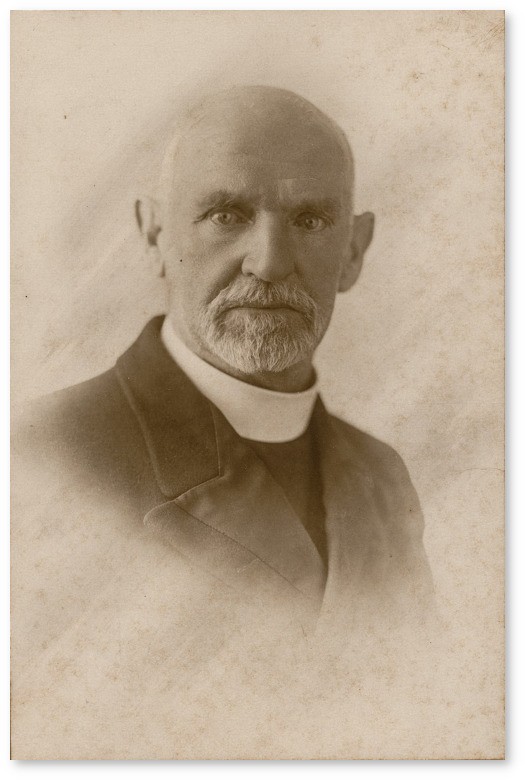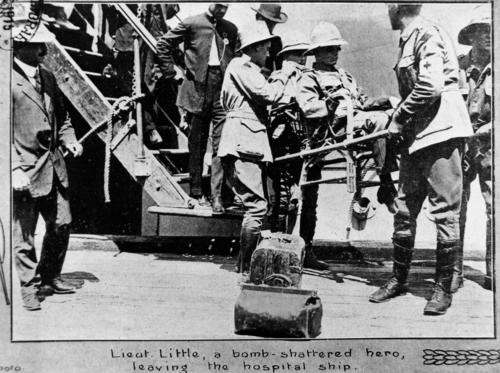The Inspiring Story of Edwin Maurice Little: 15th Battalion (No. 309)
By JOL Admin | 25 January 2016

At left: Lieutenant E.M. Little of the 15th Infantry Battalion, published in The Queenslander, 26 June 1915, p.24.
At right: Studio portrait of Edwin Maurice Little, a copy of which hangs in the Sherwood-Indooroopilly RSL club rooms. Maurice Little was Foundation President, Sherwood Sub-branch RSSILA 1919-1924. Item 36, 32152, Edwin Maurice Little personal papers and photographs.
Guest Blogger: Ian Lang, researcher, Sherwood Methodist Church Roll of Honour
Edwin Maurice Little was born at Barcaldine on 6th July 1893, the son of the Reverend William Little, a Methodist minister and Caroline Little. He attended Brisbane Grammar School from 1907 to 1909, passing the Sydney Junior Public Examination (Queensland would not introduce its own public examinations until 1915). Whilst at Grammar he captained the 1st XI Cricket Team.
Sometime in his early life he began to be known by his middle name, Maurice and signed his name as E. Maurice Little. He became a teacher with the Department of Public Instruction teaching at the Brisbane Normal School before being transferred to Gladstone where he enlisted on 16th September 1914.

The Boys' Central (Normal) State School, Brisbane, published in The Queenslander, 13 September 1919, p. 22. State Library of Queensland.
At the time of his enlistment, Maurice was 21 years old and reported that he had held a commission of 2nd Lieutenant in the senior cadets before being transferred to Gladstone. He named his father, Rev William Little as his next of kin and gave his father’s address as Pine Street, North Ipswich.
After enlisting in Gladstone, Maurice would have travelled to Rockhampton to take a coastal steamer to Brisbane (The coastal railway line was not completed until 1924 and there was no rail link between Brisbane and Rockhampton at the time) Upon arrival at Enoggera Maurice was drafted into the 15th Infantry Battalion as a sergeant on 1 October 1914.
The 15th Battalion, under the command of Lt Colonel William “Bull” Cannan (who had strong connections to the Sherwood Shire) travelled to Melbourne to join the rest of the 4th Brigade commanded by Brigadier General John Monash. Monash’s brigade embarked on the “Ceramic” on 22nd December 1914 to join the Australian contingents that had just arrived in Egypt.
Some time was spent in training at the Mena Camp on the outskirts of Cairo before the 4th brigade embarked on the 12th April 1915 in preparation for landing at Gallipoli. The 15th Battalion landed at about 4:00pm on the afternoon of the 25th April and immediately moved up a narrow gully towards the edge of an escarpment where they established a defensive line. The place would become known as Quinn’s Post named after a captain in the 15th Battalion. Quinn’s was furthest point reached by the Australians on the first day and would remain so throughout the campaign. The trenches were located on the edge of the escarpment and the Turkish trenches were very close.

Australian soldiers at Gallipoli, 7 August 1915. This image was donated to the Australian War Memorial by Mrs E.M. Little. Photographer unknown. Image courtesy Australian War Memorial, Accession number: H12744.
The 15th Battalion continued to garrison Quinn’s Post with short rests in the gully below; the battalion suffering continual casualties due to sniping and Turkish bombs. On 14th May, Maurice was commissioned as a 2nd Lieutenant to make up for the loss of officers.
On 24 May a short cease fire was arranged to allow both sides to bury their dead that lay between the lines. Firing commenced again at 5:00pm. A Turkish mine was exploded under the Anzac trenches at Quinn’s two days later and the Turks captured part of the trench system. Lieutenant Little and another man were attempting to hold back an advance along a trench. Accounts vary as to the events that transpired. Some reports indicate that Maurice was injured while attempting to throw a jam tin bomb of his own. Such an explanation is plausible as the jam tin bombs used by the Australians were rather crudely made with unreliable fuses.

Australian troops practising bomb throwing at Gallipoli. This was an important skill as the trenches were very near to each other at various points. Photographer Ernest Brooks, 1915. Image courtesy, Australian War Memorial image, Accession: G00406
Newspaper accounts from 1916, most likely based on his own testimony, describe how Maurice was throwing Turkish bombs back at the enemy before they exploded. He had done so successfully six times but on the seventh occasion the bomb exploded in his hand. On 29th May, Maurice was transferred to the Hospital Ship “Gascon” where his right eye was removed. Upon arrival at the Australian General Hospital at Heliopolis in Cairo, his right hand and wrist were amputated and also his left eye had to be removed. In addition to losing both eyes and his right hand, Maurice also had a severe wound in his left knee which became infected.
His father, Rev Little was advised by telegram that Maurice was wounded – “not seriously”. A casualty list published in the press listed him as killed in action. The Rev Little asked for clarification from Base Records in Melbourne and was curtly advised that Base Records had not released casualty lists to the press. This sorry part of the story exemplifies the complete lack of planning that had gone into communications in the early part of the war. It is true that the high number of casualties at Gallipoli were not anticipated, but it does not explain the lack of information provided to families of those wounded; and it certainly does not excuse the erroneous “not seriously”. The standard response from the authorities was to word a curt telegram – “Regret advise # wounded. Further information forwarded as it comes to hand.” Any request for information by relatives was usually met with “In the absence of information to the contrary, it is to be assumed that satisfactory progress is being maintained.” It would seem that the Rev. Little was very distressed by the inaccurate reports and he obviously made his views known to his compatriot; Rev. William Brown of Sherwood. In spite of his shocking injuries, Maurice did make steady progress, due in part to the ministrations of a Miss Lizzie (in some accounts she is named as Bessy, or Bessie) Crowler. Miss Crowler had been a English missionary for the Church Home Mission in the Sudan for the previous 12 years and had come to Cairo on furlough. Lizzie became a volunteer nurse at Heliopolis and by all reports was instrumental in hastening Maurice’s convalescence.

Studio portrait of Reverend William Little, father of E.M. Little. Item 37, 32152, Edwin Maurice Little personal papers and photographs, State Library of Queensland.
Maurice and Lizzie were married by an Army chaplain in Cairo, Lizzie was 22 years Maurice’s senior. It was reported that Maurice had to be carried to the ceremony in a chair as his knee wound prevented him from walking. On 15th October 1915 Maurice and Lizzie boarded the “Kanowna” bound for Australia. At the first port of call, Freemantle, the press came on board and interviewed the couple. This resulted in a number of subsequent stories in Australian newspapers including the Ipswich Times.

Lieutenant Little "a bomb-shattered hero, leaving the hospital ship", "The Queenslander" 11 December 1915, p.27
When Maurice appeared before a medical board in Brisbane, it was determined that he should be discharged as medically unfit. In addition to having lost the sight of both eyes and his right hand, the board noted that his leg wound had become inflamed with arthritis, he was suffering hearing loss in his right ear and he had lost several teeth. Maurice was granted a pension of 41 pounds a year and Lizzie; who was now known as Lizzie Maurice Little was granted 45 pounds a year as Maurice’s primary carer.
Maurice spoke at a public meeting in the Ipswich Town Hall, even though he could not stand, where he encouraged young men to answer the call. The Bible Society donated the complete 29 volumes of the Braille Bible; as Maurice had mastered Braille while in Egypt with Lizzie’s help. In spite of his disability, Maurice stood unsuccessfully for State Parliament in the seat of Bremmer on a Nationalist ticket in 1918.
Maurice and Lizzie moved to Corinda to make their home and at the end of the war Maurice became the inaugural President of the Sherwood RSSAILA (Returned Soldiers and Sailors Imperial League; now known as the RSL). Maurice unveiled the Sherwood Shire War Memorial in Graceville Memorial Park on 29th November 1920. Also present at the unveiling was Maurice’s old battalion commander, Brig General “Bull” Cannan who was by then State president of the RSSAILA. One of Maurice’s earlier poems, 'The True Memorial' perhaps captures the moment of the occasion:

E. Maurice Little "Sonnets & Other Poems" Brisbane: Queensland Book Depot, 1923. John Oxley Library, Call No. P A821.2 LIT
Maurice wrote extensively for publications like "The Queenslander”; and it would have been a daunting task to use a typewriter. He was described in a number of articles and reviews as a man with enduring cheerfulness and faith. Maurice refused to be seen as an object of pity and wrote a long article on blindness (Blindness Described From Within) which was published in the Maryborough Chronicle, 16 August 1920 p.6, in which he contended the blind were not suffering from an affliction; and hence deserved pity, but rather a handicap (in modern times even handicap is considered incorrect with the term disability more correct). In 1923 Queensland Book Depot published “Sonnets and Other Verses” which contained a preface by Mr. Bousfield, Headmaster of Brisbane Grammar. The publication also contained two poems relating to the war, including The True Memorial, as well as a verse on the Grammar motto “Nil Sine Labore.”

'The Veteran's Song' by E M Little
In 1925 Maurice and Lizzie went to England where Maurice studied economics at Oxford for three years. When they returned to Australia the couple lived in Sydney for a time where Maurice pursued a writing career including two short stories, “The Joker” and “A Large Order” in the 1930’s.
Maurice died in Bromley, London on 19th August 1938 at the age of 45. He was survived by his father William, wife Lizzie, sister Alice and brothers Arnold, Arthur and Leslie. Obituaries appeared in the Brisbane Telegraph, The Queensland Times (Ipswich), The Queensland Methodist Times and the Maryborough Chronicle.
E. Maurice Little was a man of strong character who refused to see his disability as an impediment to a full and fruitful life. His strong Methodist upbringing, and the faith that derived from it, sustained him through many difficulties. E. Maurice Little is commemorated in one of the stories on the Bible Society website, "Their Sacrifice".
Guest Blogger: Ian Lang, researcher, Sherwood Methodist Church Roll of Honour.
View the collection ...
32152, Edwin Maurice Little personal papers and photographs
Read more ...
Service record: Little, Edwin Maurice, National Archives of Australia, Series B2455, Item ID 8203938
[Content updated April 2024]
Comments
Your email address will not be published.
We welcome relevant, respectful comments.